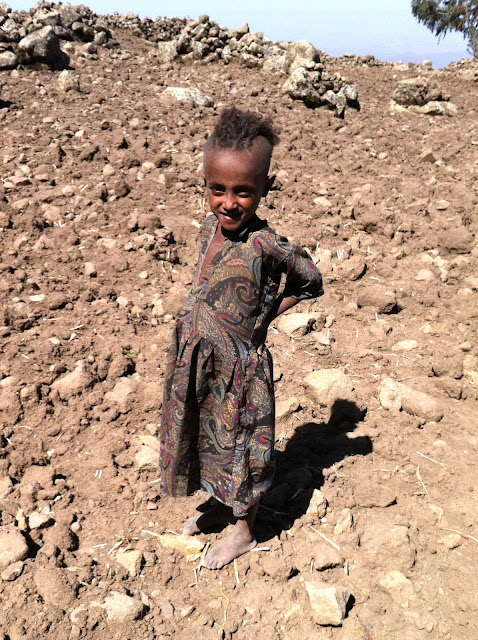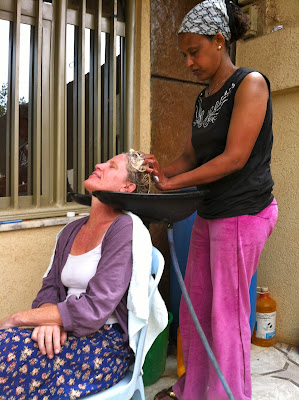This post is really for the two new volunteers who are arriving May 31, Matthew from England and Adele from South Africa. I've sent them this as an attachment, but I promised I would post it here as well in case they couldn't read the attachment. My point: You're welcome to read this but it might not interest you ;):
Mercy
Ministry Kindergarten Class Information
The Mercy Ministry kindergarten class is
comprised of 15 students of widely diverse skill levels in math and English.
The students range from age 5 possibly to age 7 or 8. They are eager learners,
respectful, and pretty well disciplined for children of their age. Their
support of one another is impressive—despite some minor, common
competitiveness, I’ve never seen anyone undermine another student’s success
maliciously. The higher-level kids are very patient in waiting for responses
from the less advanced students and it’s common for them to help one another
along by explaining instructions over again in Ahmaric, showing them how to do
something on a worksheet, and certainly applauding at a successful answer.
We’ve chosen to divide the kids into groups
to help facilitate their learning and our own ability to provide as much
developmental opportunity as possible. I’d like to believe that the kids are
not aware of each group’s dynamic or ability—we’ve never made an issue of it
nor honored one group over another. The division, however, does provide
opportunity to move one group ahead even on an identical worksheet.
Hopefully this brief summary of group
dynamics and individual skill levels will enable the next volunteers to pick up
where we left off rather than waste precious time trying to determine where to
begin, as we had to do. The kids are ripe to learn and perfectly capable. I
suggest that you set general goals for achievement for your tenure here, then
develop individual lesson plans to work toward achieving those goals; note that
you are only contributing a section of a continuum! You’ll likely want to be
able to do more, but what you will achieve while you’re here is relevant and
important, if not the end-all. That is Beza’s and the Home’s ultimate prize.
General Challenges:
The style of recitation teaching here has
certainly hindered overall achievement: as in any group dynamic, the weaker
voices are drowned out and their challenges have not been addressed. We’ve
worked hard at empowering individuals—both strong and weak—to develop
self-confidence and leadership by asking for independent answers; giving an
individual student an opportunity to instruct a brief topic to the others; and
by largely discontinuing “learning” activities like reciting the alphabet or
counting to 50 in a group except for fun or games.
There is an overall propensity to finish
quickly, which is a catalyst for copying one another’s work. We’ve gone to
great lengths to undermine this practice, going so far as moving habitual
perpetrators to their own work area for a lesson.
Keep in mind that English is the children’s
second language; don’t let this be a handicap, but do bring it to mind when you
get a blank stare from a student whom you believe to be intelligent and
capable: asking Beza to interpret the question again may yield the correct
response and help you learn whether the issue is language or comprehension.
Resources are scant. Organization and
planning will go a long way to ensuring that you have everything you need for a
successful lesson. For your convenience, I’ve provided a lesson plan for the
first class you’ll teach, which will at the least reflect where we’ve left off
and at best will give you something to grasp onto as you organize yourself for
subsequent classes. Note that I basically made up the structure, having
virtually nothing to go on when I arrived; that is to say that there’s not much
sacred about the topics of each class period and if you find a more effective
way to impart information, go for it.
Robin purchased a printer that can be used
as a copier, but it’s been a challenge finding cartridges (they’re here in
Addis Ababa, we just can’t find them J).
Consequently, we’ve had to resort to getting photocopies while in the city
working at the feeding center, which is time consuming and at your expense
(about 3¢/copy); further, the copies we’ve gotten, despite trying various
resources, are of poor quality and we’ve learned to COUNT to ensure we have how
many we asked for.
Printer Information
HP Deskjet 2050
All-In-One J510
Cartridge Black 61
Tri-Color 61
Daily Schedule
Blue = Volunteer responsible for lessons Monday, Tuesday, Thursday
9:30–10:30 Vocabulary
10:30–11:00 Recess
11:00–12:00 Math
12:00–2:00 Lunch, Nap
2:00–3:30 Creative arts
3:30–4:00 Recess/Change clothes
4:00–4:30 Dinner
4:30 Kids
depart
Teacher: Beza (BEE-zuh)
 Beza
is the full-time teacher at Mercy Ministry school. She’s young and relatively
inexperienced, but is qualified by these standards to teach kindergarten. Her
lack of experience shows in her disinterest in engaging with the kids while
we’re teaching; do not hesitate to ask her to take leadership of a learning
group or to interpret instructions, stories, etc. for you; she does not do this
instinctively. NOTE: Sometimes she gives the kids the answer when you didn’t
really want her to—if a worksheet is done perfectly, be suspicious of how much
input she provided the kids to complete the task. Remember that English is a
second language for her as well. She also has not been too communicative about
what the kids are learning in Ahmaric on the days we don’t teach, so we’re at a
bit of a loss when it comes to understanding their pacing in English versus
their native language; in an ideal world, lessons and skills would be
reinforced in both languages simultaneously. She is strict about the schedule
and will manage the kids’ arrival, meals, and departure at day’s end. She also
takes them to recess; we’ve been inconsistent about participating in recess,
primarily because we’re getting ready for the next lesson (not for lack of
interest).
Beza
is the full-time teacher at Mercy Ministry school. She’s young and relatively
inexperienced, but is qualified by these standards to teach kindergarten. Her
lack of experience shows in her disinterest in engaging with the kids while
we’re teaching; do not hesitate to ask her to take leadership of a learning
group or to interpret instructions, stories, etc. for you; she does not do this
instinctively. NOTE: Sometimes she gives the kids the answer when you didn’t
really want her to—if a worksheet is done perfectly, be suspicious of how much
input she provided the kids to complete the task. Remember that English is a
second language for her as well. She also has not been too communicative about
what the kids are learning in Ahmaric on the days we don’t teach, so we’re at a
bit of a loss when it comes to understanding their pacing in English versus
their native language; in an ideal world, lessons and skills would be
reinforced in both languages simultaneously. She is strict about the schedule
and will manage the kids’ arrival, meals, and departure at day’s end. She also
takes them to recess; we’ve been inconsistent about participating in recess,
primarily because we’re getting ready for the next lesson (not for lack of
interest).
Achievement Groups
First
Group (lowest)
Yabsra (small) and Kalid are markedly lower
in skill level in all areas than all the other kids in the class. We have found
it best to provide them with separate worksheets sometimes to help them work at
their own skill level, however, they (Yabsra especially) do feel slighted if
they see the kids doing something different. Note that Malkamu and Bahilu often
work in their own group because they are pretty far ahead of Yabsra (small) and
Kalid, but far enough behind the others that it interferes with the higher
groups’ progression and their own learning.
Kalid CAL-id
 Kalid
doesn’t speak much. Regretfully, he doesn’t seem to comprehend too much,
either, but he tries by guessing. I would say his skill level is the lowest in
the class, slightly beneath Yabsra (small), but he doesn’t seem intimidated or
ashamed or cognizant of his lesser abilities. He loves to draw and seems to
have some talent there. He can trace lines/letters more neatly than Yabsra;
like Yabsra, he seldom identifies numbers or letters and has seemingly no
understanding of the value of a numeral. He can recite the alphabet and count,
but must always start at the beginning. He responds well to positive
reinforcement.
Kalid
doesn’t speak much. Regretfully, he doesn’t seem to comprehend too much,
either, but he tries by guessing. I would say his skill level is the lowest in
the class, slightly beneath Yabsra (small), but he doesn’t seem intimidated or
ashamed or cognizant of his lesser abilities. He loves to draw and seems to
have some talent there. He can trace lines/letters more neatly than Yabsra;
like Yabsra, he seldom identifies numbers or letters and has seemingly no
understanding of the value of a numeral. He can recite the alphabet and count,
but must always start at the beginning. He responds well to positive
reinforcement.
Yabsra (small) YAWB-sra
 Due
to illness last fall, Yabsra suffered hearing loss, which certainly impacts her
learning ability. She has become more confident in the last month, sometimes to
the point of bossy, especially with Kalid. She sometimes shows a flash of
comprehension, naming a letter correctly or handing you “two” chips when you
ask for two. She rushes through even tracing and is stubborn about doing things
her own way. She can count, but must always begin at “1.” Needs work
identifying numbers; understanding the meaning of numbers (can’t relate
quantity to a numeral). She can recite the alphabet and recognize her name, but
is inconsistent in identifying a letter correctly and cannot tell you the sound
the letter makes. Unclear as to how much of this is comprehension vs hearing vs understanding English; she benefits from interpretation from
Beza.
Due
to illness last fall, Yabsra suffered hearing loss, which certainly impacts her
learning ability. She has become more confident in the last month, sometimes to
the point of bossy, especially with Kalid. She sometimes shows a flash of
comprehension, naming a letter correctly or handing you “two” chips when you
ask for two. She rushes through even tracing and is stubborn about doing things
her own way. She can count, but must always begin at “1.” Needs work
identifying numbers; understanding the meaning of numbers (can’t relate
quantity to a numeral). She can recite the alphabet and recognize her name, but
is inconsistent in identifying a letter correctly and cannot tell you the sound
the letter makes. Unclear as to how much of this is comprehension vs hearing vs understanding English; she benefits from interpretation from
Beza.
Malkamu mal-KAHM-yew
 Malkamu
(and Bahilu) is significantly above Kalid and Yabsra (small), but is far enough
behind others in the class that we’ve put him in this group for convenience,
frankly. His biggest handicap is his lack of confidence; he believes he can’t
understand so he doesn't and looks to Beza often. He recites in a group fine,
but when called on independently, clams up and often fails. With patience, he
can fairly often come up with the correct response. He is unable to
consistently identify a numeral with its quantity, however, and cannot
comprehend addition. We’ve worked on “grouping” with him and have progressed in
helping him understand quantity, but needs more work. His hand coordination is
fine, he enjoys participating, he just always seems on edge about giving an
answer on his own.
Malkamu
(and Bahilu) is significantly above Kalid and Yabsra (small), but is far enough
behind others in the class that we’ve put him in this group for convenience,
frankly. His biggest handicap is his lack of confidence; he believes he can’t
understand so he doesn't and looks to Beza often. He recites in a group fine,
but when called on independently, clams up and often fails. With patience, he
can fairly often come up with the correct response. He is unable to
consistently identify a numeral with its quantity, however, and cannot
comprehend addition. We’ve worked on “grouping” with him and have progressed in
helping him understand quantity, but needs more work. His hand coordination is
fine, he enjoys participating, he just always seems on edge about giving an
answer on his own.
Bahilu buh-HI-lu
 Bahilu
(and Malkamu) is significantly above Kalid and Yabsra (small), but enough
behind the others to warrant more/different attention. He is slow to complete
worksheets, although works hard at them; he’s tedious in tracing numbers and
letters, but doesn’t seem to grasp that they’re a “character”—he will turn the
paper whatever direction yields the cleanest line rather than starting at the
top and finishing a letter without allowing his pencil to leave the page. He
guesses rather than thinks about the challenge, but with patience in a
response, he comes up with the correct answer more often than Malkamu. He also
cannot relate a numeral to its quantity, but is more advanced in his ability to
identify letters and their sounds than Malkamu.
Bahilu
(and Malkamu) is significantly above Kalid and Yabsra (small), but enough
behind the others to warrant more/different attention. He is slow to complete
worksheets, although works hard at them; he’s tedious in tracing numbers and
letters, but doesn’t seem to grasp that they’re a “character”—he will turn the
paper whatever direction yields the cleanest line rather than starting at the
top and finishing a letter without allowing his pencil to leave the page. He
guesses rather than thinks about the challenge, but with patience in a
response, he comes up with the correct answer more often than Malkamu. He also
cannot relate a numeral to its quantity, but is more advanced in his ability to
identify letters and their sounds than Malkamu.
This group of kids can and do learn, some
quickly, but their skill levels are still a little diverse, which can make them
a challenge to teach effectively. Still, they definitely work better on their
own that the other group, but generally are “anxious”; make sure they
understand the goal before they begin any exercise. They tend to
compete against one another and copy one another, which has made identifying
their individual strengths and weaknesses a challenge, as well as their
progression.
Hewot HEW-it
 We
have had Hewot in the group with Malkamu and Bahilu up until our last week, but
believe that she will excel in this group, a situation where the other two may
be holding her back (she often explained things to the other two and typically
worked ahead of their pace). Still, she suffers for understanding and seems to
be in a dreamland a lot; she benefits from Beza’s interpretation, but needs to
try harder to comprehend English … she’s capable, but a bit lazy. With
practice, translation, focus, and patience, she has shown that she can
comprehend and learn, whereas the others in the First Group seem to be on a
spin cycle. In our tenure, Hewot has begun to realize the relationship between
a numeral and its quantity, she can identify letters and often the sound they
make.
We
have had Hewot in the group with Malkamu and Bahilu up until our last week, but
believe that she will excel in this group, a situation where the other two may
be holding her back (she often explained things to the other two and typically
worked ahead of their pace). Still, she suffers for understanding and seems to
be in a dreamland a lot; she benefits from Beza’s interpretation, but needs to
try harder to comprehend English … she’s capable, but a bit lazy. With
practice, translation, focus, and patience, she has shown that she can
comprehend and learn, whereas the others in the First Group seem to be on a
spin cycle. In our tenure, Hewot has begun to realize the relationship between
a numeral and its quantity, she can identify letters and often the sound they
make.
Yabsra (boy) YAWB-sra
 Yabsra
(boy) is a tough one … he concentrates hard, he is meticulous when it comes to
writing, drawing, coloring, he has absolutely no problem being the last one in
the class working diligently at finishing something, but his comprehension is
disappointing: we are repeatedly let down with no answer or a wrong answer. We
haven’t been able to figure out his learning challenge, to be honest. He’s
intelligent, he seems to understand English fairly well, but he definitely
lacks confidence. Like others in this group, he understands numbers fairly well,
can succeed at grouping like objects, and the idea of addition is dawning on
him.
Yabsra
(boy) is a tough one … he concentrates hard, he is meticulous when it comes to
writing, drawing, coloring, he has absolutely no problem being the last one in
the class working diligently at finishing something, but his comprehension is
disappointing: we are repeatedly let down with no answer or a wrong answer. We
haven’t been able to figure out his learning challenge, to be honest. He’s
intelligent, he seems to understand English fairly well, but he definitely
lacks confidence. Like others in this group, he understands numbers fairly well,
can succeed at grouping like objects, and the idea of addition is dawning on
him.
Temesgen TUM-es-gen
 Temesgen’s
biggest hurdle at this stage is mostly just being “all boy”: can’t sit still
for long, is competitive, and can lose focus. Otherwise, he is intelligent and
eager to please. He’s the kid who will jump in to get something finished and
get it all wrong, but when he slows down and understands the task, he typically
succeeds. His photo doesn’t reflect his self-confidence and exuberance (because
he’d been slighted on the playground and had been crying, the only time I saw
any of them cry as it related to their ego J). Temesgen responds well to positive reinforcement; he enjoys
learning and seems to challenge himself to excel.
Temesgen’s
biggest hurdle at this stage is mostly just being “all boy”: can’t sit still
for long, is competitive, and can lose focus. Otherwise, he is intelligent and
eager to please. He’s the kid who will jump in to get something finished and
get it all wrong, but when he slows down and understands the task, he typically
succeeds. His photo doesn’t reflect his self-confidence and exuberance (because
he’d been slighted on the playground and had been crying, the only time I saw
any of them cry as it related to their ego J). Temesgen responds well to positive reinforcement; he enjoys
learning and seems to challenge himself to excel.
Meseret MEZ-er-et
 Like
some of the other girls, Meseret lacks self-confidence, which inhibits her
learning. She is smart, but it takes work to get her to concentrate on her own
paper. On the few occasions when she’s been responsible for her own work, she
proves that she can do well and sometimes better than the others in her group …
regretfully, those times are infrequent. We have literally moved her away from
the table on occasion, which helps. In group situations with the whole class,
she can answer questions about letters, relative sizes, language, etc.,
correctly, but she’ll often whisper, revealing her inhibited nature.
Like
some of the other girls, Meseret lacks self-confidence, which inhibits her
learning. She is smart, but it takes work to get her to concentrate on her own
paper. On the few occasions when she’s been responsible for her own work, she
proves that she can do well and sometimes better than the others in her group …
regretfully, those times are infrequent. We have literally moved her away from
the table on occasion, which helps. In group situations with the whole class,
she can answer questions about letters, relative sizes, language, etc.,
correctly, but she’ll often whisper, revealing her inhibited nature.
Hayder HIGH-der
 Hayder
is a pistol, which mostly serves him well; he can get over-excited and
therefore get himself into some small discipline trouble, but he defines “eager
to learn.” If it weren’t for his competitiveness to finish first, be the best,
and be the center of attention, he’d probably be further in his academic
development, but he does well and is at the top of this group. He comprehends
numbers, their meaning, grouping, and is fair at addition. He loves learning
and speaking English and does so well; he knows his vowels and the sounds of
letters most of the time. Sometimes his enthusiasm trips up his concentration,
but overall Hayder should be absorbing and therefore moving forward with great
strides as the school year ends.
Hayder
is a pistol, which mostly serves him well; he can get over-excited and
therefore get himself into some small discipline trouble, but he defines “eager
to learn.” If it weren’t for his competitiveness to finish first, be the best,
and be the center of attention, he’d probably be further in his academic
development, but he does well and is at the top of this group. He comprehends
numbers, their meaning, grouping, and is fair at addition. He loves learning
and speaking English and does so well; he knows his vowels and the sounds of
letters most of the time. Sometimes his enthusiasm trips up his concentration,
but overall Hayder should be absorbing and therefore moving forward with great
strides as the school year ends.
This highest-level group is more homogenous
than the others, which of course makes them easier to teach. They can work well
on their own if attention is needed in the other groups, but can also be
competitive with one another, primarily for resources (not unusual to put a
fistful of crayons on the table and everyone rushes for them like hungry dogsJ). Generally,
this group should begin reading within a few weeks; regretfully, there are not
a lot of early-reader materials, particularly things that will engage their
interest (such as Dr. Suess books); there are enough workbooks around, though,
that when that time comes, someone may be able to cobble some sentences
together.
Yabsra (girl) YAWB-sra
 Yabsra
(girl) has been making amazing strides in the last few weeks, revealing her
confidence, intelligence and potential. We’ve only moved her into this group
during our last week, although she did well (was not held back by) the middle
group she’d been in. It’s our hope that putting her with the quicker, more
developed kids will bring her even further in her ability. She enjoys learning
and doing well (although she’s indifferent about her coloring neatness), she
can identify numbers, letters, and the sounds letters make. She is beginning to
put letters together to form words (C+at = Cat) and will likely excel quickly
here. She focuses on and takes pride in her work and doesn’t tend to copy
others. With numbers, Yabsra is confident and understands quantities and groups
and is ready to move further in addition; I suspect she will pick up
subtraction as well.
Yabsra
(girl) has been making amazing strides in the last few weeks, revealing her
confidence, intelligence and potential. We’ve only moved her into this group
during our last week, although she did well (was not held back by) the middle
group she’d been in. It’s our hope that putting her with the quicker, more
developed kids will bring her even further in her ability. She enjoys learning
and doing well (although she’s indifferent about her coloring neatness), she
can identify numbers, letters, and the sounds letters make. She is beginning to
put letters together to form words (C+at = Cat) and will likely excel quickly
here. She focuses on and takes pride in her work and doesn’t tend to copy
others. With numbers, Yabsra is confident and understands quantities and groups
and is ready to move further in addition; I suspect she will pick up
subtraction as well.
Abet a-BEE-tee
 Abet
is intelligent, expressive, and thoughtful, although is quietness may imply
otherwise. But when called upon, he shows confidence and wants to please.
Understanding English can be a hurdle, but in Abet’s case, he will “tell” you
so by looking to Beza for interpretation, whereas those in the lower groups
will just give you a blank look. Once he understands, Abet typically gets the
answer correct and when he doesn’t he works hard at correcting himself and
understanding. He works independently very well and will work hard at achieving
a task correctly. He is proficient in his letters and his numbers; needs to
start counting/understanding multiples (2, 4, 6 …; 5, 10, 15 …), continuing to
work on addition, and should be subtracting by the end of the school year. He
is starting to put together words and will likely form short sentences in
writing by the end of the school year.
Abet
is intelligent, expressive, and thoughtful, although is quietness may imply
otherwise. But when called upon, he shows confidence and wants to please.
Understanding English can be a hurdle, but in Abet’s case, he will “tell” you
so by looking to Beza for interpretation, whereas those in the lower groups
will just give you a blank look. Once he understands, Abet typically gets the
answer correct and when he doesn’t he works hard at correcting himself and
understanding. He works independently very well and will work hard at achieving
a task correctly. He is proficient in his letters and his numbers; needs to
start counting/understanding multiples (2, 4, 6 …; 5, 10, 15 …), continuing to
work on addition, and should be subtracting by the end of the school year. He
is starting to put together words and will likely form short sentences in
writing by the end of the school year.
Fkadu fuh-KAH-du
 Fkadu
is an intelligent boy who enjoys learning and absorbs new information well. He
can sometimes be a little busy and undermine his success, but generally he
excels at what he does. He and Sintayhu are competitive with one another, which
doesn’t serve either well in the classroom. Fkadu enjoys having the answer, has
strong leaderships skills that can continue to be capitalized on, and takes
great pride in his accomplishments. He is good at numbers and beginning to
comprehend how to build words. He learns well from challenges like puzzles and
games.
Fkadu
is an intelligent boy who enjoys learning and absorbs new information well. He
can sometimes be a little busy and undermine his success, but generally he
excels at what he does. He and Sintayhu are competitive with one another, which
doesn’t serve either well in the classroom. Fkadu enjoys having the answer, has
strong leaderships skills that can continue to be capitalized on, and takes
great pride in his accomplishments. He is good at numbers and beginning to
comprehend how to build words. He learns well from challenges like puzzles and
games.
Sintayhu sin-TIE-hew
 A
smart child, Sintayhu has a little temper that occasionally flares at others,
particularly Fkadu it seems. His slight lack of self-confidence may be the root
of this behavior, but he has no reason to feel slighted … he’s very capable and
needs to focus on his own strengths rather than worry about other kids. It’s
possible that this trait has held him back a little in his academic
development; in fact, he may be a little bored/unchallenged and get himself
into trouble. He knows letters and numbers, but rushes through and looks around
to see the status of others, consequently falling short of his potential. Like
the others in this group, he’s ready to move forward in addition, probably
subtraction, and word formation/reading.
A
smart child, Sintayhu has a little temper that occasionally flares at others,
particularly Fkadu it seems. His slight lack of self-confidence may be the root
of this behavior, but he has no reason to feel slighted … he’s very capable and
needs to focus on his own strengths rather than worry about other kids. It’s
possible that this trait has held him back a little in his academic
development; in fact, he may be a little bored/unchallenged and get himself
into trouble. He knows letters and numbers, but rushes through and looks around
to see the status of others, consequently falling short of his potential. Like
the others in this group, he’s ready to move forward in addition, probably
subtraction, and word formation/reading.
Lemlem LEM-LEM
 Lemlem’s
lack of confidence defies her ability: it’s telling that she repeatedly wins
hands-down at Simon Says, but is frozen to futility when asked to lead the
game. She sometimes behaves immaturely to her intellect, but consistently
provides correct answers and evidence of understanding. Still, she looks to
others for approval and confidence, but gleams when she arrives at the correct
answer on her own. She may need some 1:1 work to build her confidence and
understand her own ability, which certainly will provide her with momentum to
move forward more quickly.
Lemlem’s
lack of confidence defies her ability: it’s telling that she repeatedly wins
hands-down at Simon Says, but is frozen to futility when asked to lead the
game. She sometimes behaves immaturely to her intellect, but consistently
provides correct answers and evidence of understanding. Still, she looks to
others for approval and confidence, but gleams when she arrives at the correct
answer on her own. She may need some 1:1 work to build her confidence and
understand her own ability, which certainly will provide her with momentum to
move forward more quickly.
Frewhiwot free-HU-it
 Frewhiwot
leads the class in ability and understanding; consequently, we’ve challenged
her in different ways (i.e., when Bahilu is asked to find “yellow” in the
classroom, Frewhiwot may come to the white board to write the word “yellow”)
and she’s excelled during our tenure. She’s ready to read and write words;
regretfully, the burden of 14 other students has kept us from pushing her
further in these arenas. Frewhiwot is helpful to others in their learning. She
demands much of herself but should be challenged further with addition,
subtraction and reading.
Frewhiwot
leads the class in ability and understanding; consequently, we’ve challenged
her in different ways (i.e., when Bahilu is asked to find “yellow” in the
classroom, Frewhiwot may come to the white board to write the word “yellow”)
and she’s excelled during our tenure. She’s ready to read and write words;
regretfully, the burden of 14 other students has kept us from pushing her
further in these arenas. Frewhiwot is helpful to others in their learning. She
demands much of herself but should be challenged further with addition,
subtraction and reading.
Suggested First Lesson Plan
Day 1 (Monday,
June 4)
9:30–10:30: Vocabulary
The kids are generally eager
to get going. Some days I would start them at their desk, other days seated
facing the alphabet, still other days on the floor. If they were tired, I’d
throw in a game after “good mornings” (which we habitually did, including creating
mock scenarios where the kids greet one another). Generally, my morning session
was always structured around:
- Greetings, names,
please/thank you;
- Expressions/Emotions OR Body
Parts OR Colors (we’ve covered colors) OR etc. Here I was looking for an
engaging, creative way to expand their English vocabulary without the
high-structure of worksheets .. basically something fun;
- Vocabulary, the “meat” of
the morning lesson, which has developed over time from identifying letters,
finding missing letters, vowels/consonants, phonics, and word creation, which
is where we left off.
1. Introductions (this
will take time and that’s fine)
Greet individual students to learn names:
- “Hi, my name is Matthew” [shake hand; each child
will likely respond: “Good morning, Matthew, how are you?” They’ll expect you
to respond: “I’m fine, thank you, how are you?”]
- Repeat with Adele.
- Reinforce your names by writing them on the
white board and working through “reading” your names with them.
- You could do an
activity where the kids write their own names on a sticker/name tag if you
bring some blank stickers/nametags with you. This would give them a writing
skill exercise and you a leg up on figuring out who’s who. You would be well
served drawing lines on the tags for the First Group.
- You might know a “name game” to accomplish this:
for example, stand in a circle and throw a bean bag to someone who announces
their name, then tosses the bean bag to someone else.
2. Practice Left and
Right
We’ve started “left” and “right” and about half have
it consistently. I wrote an “L” or “R” on the back of their hands to help and
then might have requested “Left!” or “Right!” at random times throughout the
day to reinforce. You could begin the Hokey Pokey
(bring the music with your or be prepared to sing it!) in a few days. Apparently
they’ve done this before, but I find it hard to believe that it meant much to
them since their comprehension only seems to be developing, so while I had it
in my notes to do, I kept putting it off b/c they were still getting left and
right down. Now they know body parts to “put in” and L vs R, so I think will
enjoy it more.
- Play Simon Says using all “left” and “right”
commands.
- Encourage individual kids to come up to lead a
round.
3. Word Construction
We left off constructing
3-letter, rhyming words: “CAT,” “HAT,” “BAT.” There are myriad ways to teach
this, of course: we started with “–AT,” “–IT,” “–OP,” etc., and the kids worked
at adding a consonant to the beginning to form words. This can be reinforced
(they’ll have gone a week without an English teacher) and then developed
further.
We did not begin “sight
words” nor multi-consonant sounds like “TH,” “SH” and “FR.”
- Reinforce and practice “consonants” versus “vowels”
- Tape “–AT,” “–IT,” “–OP,” “–IN” to the white
board; put relative consonants on the tables and ask one student at a time to
choose a letter from the table to come to the front to make a word.
- Find a worksheet over the weekend (make 15 copies) that
encourages 3-letter word development using “–AT,” “–IT,” “–OP,” & “–IN.”
This might
include pictures to help identify the correct word. Reminder
that you’ll likely have to modify the exercise for Yabsra and Kalid; they would
benefit from a worksheet where they have to trace letters (caps/lc) OR fill in
missing letters from the alphabet, which they would need assistance with.
11:00–12:00: Numbers and Math
Robin was in charge of this
portion of the day, so I can’t give you the same detailed insight as I did
above, but here are suggestions based on my observations in assisting with this
hour. You might begin with reinforcing quantities associated with numerals;
grouping like quantities; counting by multiples; etc. The highest group will be
ready to resume simply addition by the end of this week and the middle group
soon to follow. Yabra and Kalid still need to learn what “2” means and identify
a number when it is spoken (“Find a four” and Kalid will point to a 6). Bigger
picture:, I think you could develop some games that relate to quantities or
even money, such as having to “pay a toll” with X poker chips (you may want to bring a bag of dried beans to use for these
kinds of activities) or “buying” candy with chips/beans they’ve somehow
earned. I’m leaving a big packet of individually wrapped Starbursts here for
you for rewards and such; they’re on the top bunk in the women’s room.
- Play a numbers game: We left a bunch of empty
water bottles for you, thinking you could use them to play bowling (skittles)
games. You could also fill the bottles with varying amounts of water to work on
“more” and “less.”
- Find a worksheet over
the weekend (make 15 copies) that encourages matching numerals to a group. Reminder that you’ll have to modify the exercise for Yabsra
and Kalid; they would benefit from a worksheet where they have to trace numbers
OR fill in missing numbers from a sequence. I hope you can get these two to
begin to identify a numeral with a quantity.
2:00–3:30: Creative Arts
During this period, it was
my goal to incorporate some form(s) of experiential learning to reinforce
earlier lessons or inspire creativity. Art and music are welcome and
encouraged, but neither Robin’s nor my strong suit so we probably ripped them
off a little there! “Science” would also be an appropriate subject to develop
during this period.
- Walk through the neighborhood to identify colors
and shapes, left/right, greetings, etc. (we went for a walk every Monday
afternoon).
- Sing Old
MacDonald Had a Farm and have the kids act out each animal; include silly
animals on the farm like elephants and lions. There may be time to draw a farm
animal or color one from a worksheet you’ve
found/copied. The kids love to color.
- Story time. (You should
rummage through the bookshelf in the classroom ahead of time to have story
books ready for your use; there aren’t a lot of choices appropriate to their
age group, but they love being read to and discussing the story.)
- End with educational
video (we’ve been using Thomas the Tank
Engine episodes, which I happened to bring with me; otherwise there is no
resource for educational videos).














